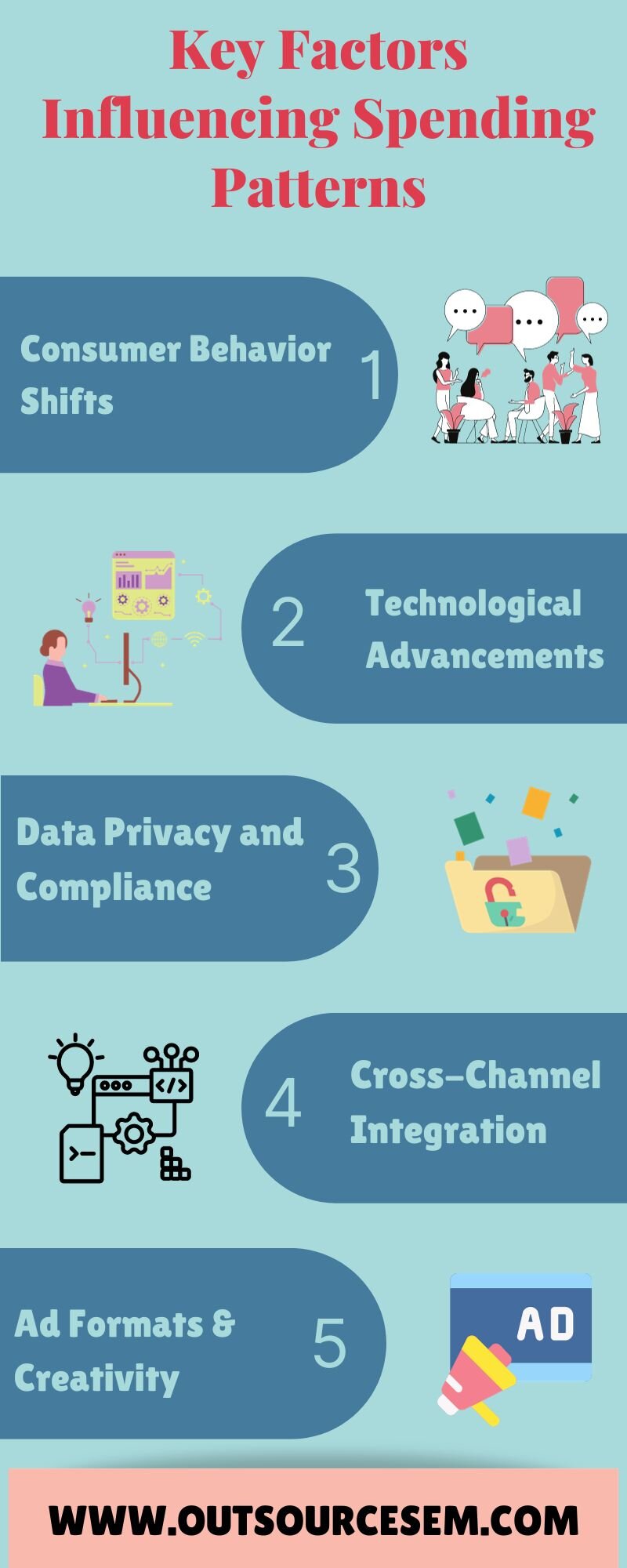Staying ahead of the curve in the ever-changing digital marketing landscape is essential for businesses looking to effectively connect with their target audience. The United States' digital ad spending forecast for 2024 presents both opportunities and challenges. According to Insider Intelligence, US retail digital ad spending will grow 14.2% next year to reach $84.00 billion. In this blog article, we will explore the forecast for US ad spending. We will also discuss how advertisers can make use of the changing PPC trends, and assess the key factors influencing spending patterns. The article will also discuss the implications for businesses navigating the digital frontier.
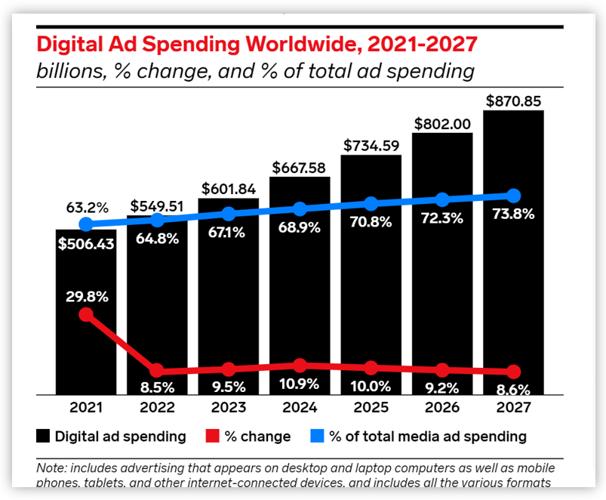
The current scenario:
Digital advertising has become an essential marketing mix component in the ever-changing marketing world. Its adaptability in reaching diverse audiences across various online platforms has transformed how businesses interact with customers. Several key factors have contributed to a consistent increase in digital ad spending in the United States over the last few years. The increase in smartphones has significantly impacted the digital advertising landscape. Advertisers have seized the opportunity to engage consumers on the go through mobile-friendly campaigns as mobile devices have become ubiquitous. As a result, marketing strategies have shifted dramatically, focusing on creating content tailored to the smaller screens of smartphones.
Meanwhile, the rapid growth of social media platforms has fueled increased digital ad spending. Channels like Facebook, Instagram, Twitter, and LinkedIn platforms have evolved into virtual marketplaces where brands can directly interact with their target audiences. The ability to leverage these platforms' large user bases and sophisticated targeting options has reshaped the advertising paradigm, allowing for more personalized and effective campaigns. Technological advancements ranging from data analytics to artificial intelligence have also played an essential role in the growing prominence of digital advertising. The ability to employ data for targeted advertising, combined with AI-driven insights, has enabled marketers to refine their strategies, improve campaign performance, and deliver more relevant content to consumers.
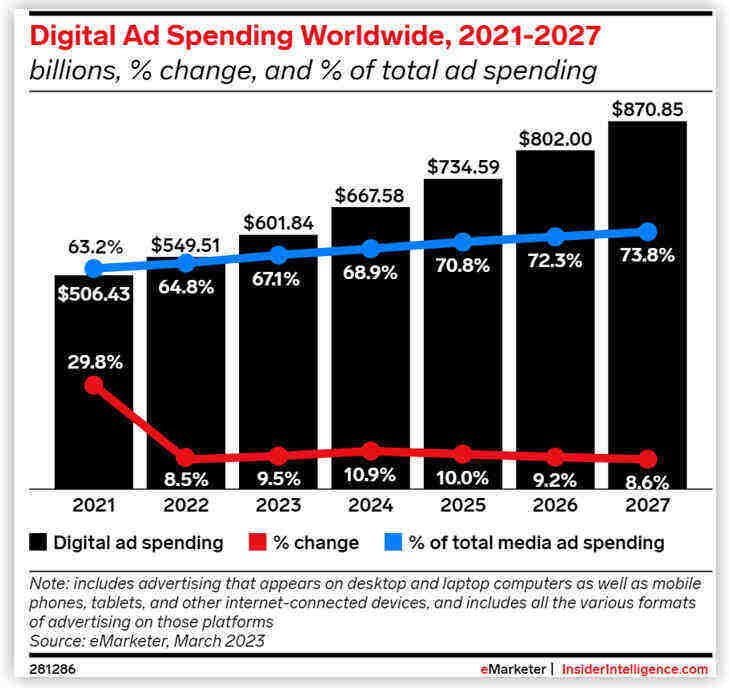
2023 Recapitulation:
i. Reflecting on the trends observed in 2023, it is clear that the year was the turning point in digital ad spending. The total expenditure reached an all-time high, emphasizing the industry's strong growth and adaptability. Various segments of digital advertising claimed a sizable share of budgets, each contributing to campaign success.
ii. Social media advertising has emerged as an influential force, accounting for a sizable portion of digital ad spending. Advertisers recognized the potential of channels like Instagram, Facebook, and TikTok to connect with audiences more personally, which led to increased investments in targeted social media campaigns.
iii. In 2023, search engine marketing (SEM) was a cornerstone of digital advertising strategies. Businesses recognized the significance of ranking high in search engine results to drive organic traffic to their websites and increase visibility. Strategic SEM investments allowed advertisers to secure valuable space on search engine results pages, ensuring their products or services were prominently displayed.
iv. With its automated and data-driven approach, programmatic advertising established itself as an efficient and effective advertising method. The ability to optimize ad placements in real-time based on user behavior and preferences contributed to programmatic advertising's widespread adoption across various sectors.
v. Influencer marketing and video content have emerged as dynamic forces in capturing consumers' attention. Using influencers to authentically promote products and services was well-received by audiences. At the same time, video content, including short-form videos and live streams, emerged as a preferred medium for engaging storytelling.
Expected trends in 2024:
1. Social media dominance - The dominance of social media in digital advertising is expected to continue and even expand in 2024. Platforms like TikTok, Instagram, and Facebook will likely capture a significant share of ad budgets due to their innovative ad formats and robust targeting options. Advertisers will continue to invest in innovative ad formats and engagement strategies to capture the attention of their target audiences as users spend more time on these platforms. The ability to tailor campaigns to specific demographics and interests will continue to be a key driver of social media's popularity to advertisers, ensuring that these platforms receive a significant share of ad budgets.
2. Video advertising growth - The rise in video content consumption is expected to continue, making video advertising a priority for marketers in 2024. Short-form videos, live streams, and interactive video ads are predicted to significantly impact digital ad spending. Advertisers understand video's storytelling power and its ability to elicit emotions and create memorable brand experiences. Advertisers will tailor their strategies to capitalize on this trend, incorporating visually compelling and shareable content into their campaigns as consumers increasingly gravitate toward video content on platforms like YouTube, Vimeo app, and emerging video-sharing apps.
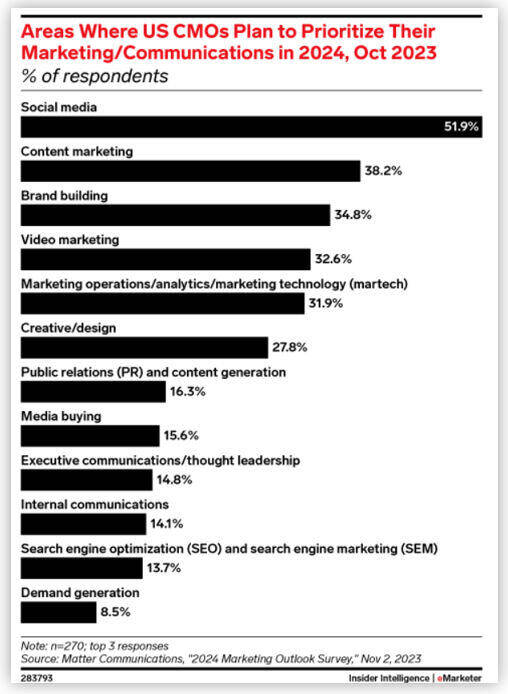
3. Increase in e-commerce advertising - The ongoing surge in online marketing is expected to result in a significant increase in e-commerce advertising. Brands will prioritize optimizing their online marketing experiences as consumers continue to embrace the convenience of digital storefronts. Advertisers will invest in targeted ads to accompany consumers from awareness to purchase throughout their online shopping journey. As brands compete for consumer attention in the competitive e-commerce landscape, expect to see an emphasis on personalized recommendations, seamless transactions, and immersive product displays.
4. Emergence of new technologies - The integration of emerging technologies, particularly Augmented Reality (AR) and Virtual Reality (VR), is expected to occur in the digital advertising landscape in 2024. These technologies will enable advertisers to engage and captivate audiences in novel ways. AR, in particular, is expected to improve user experiences by superimposing digital elements on real-world environments, whereas VR may be used for immersive storytelling. As brands seek to differentiate themselves and create memorable customer interactions, interactive ad formats such as gamified experiences and 360-degree content will be investigated.
5. Impact of data privacy and regulation - The evolving landscape of data privacy concerns and regulatory frameworks is expected to significantly impact digital ad spending in 2024. Advertisers must navigate these concerns by prioritizing transparency, ethical data practices, and regulatory compliance. Building and maintaining consumer trust will be critical, with advertisers communicating their commitment to protecting user privacy. Strategies involving first-party data, permission-based marketing, and explicit consent mechanisms will likely gain prominence as advertisers adapt to changing data privacy expectations.
Staying tuned in to these anticipated trends will be crucial for businesses seeking to optimize their marketing strategies and remain competitive in the dynamic and ever-changing world of digital marketing as the digital advertising landscape evolves.
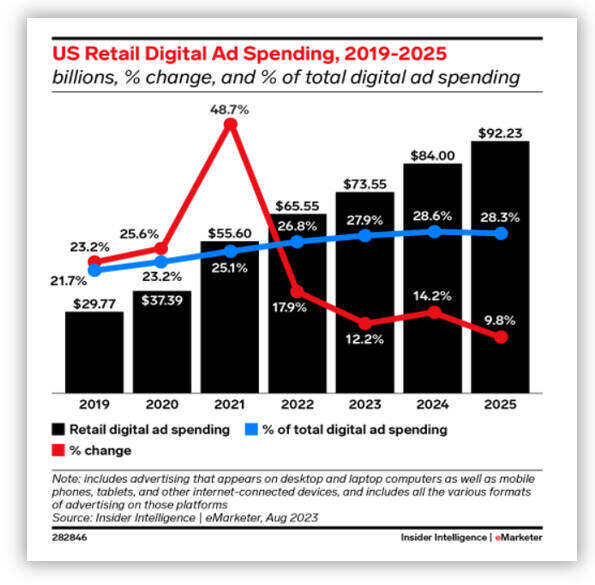
Key factors influencing spending patterns:
A. Consumer behavior shifts - Understanding and adapting to evolving consumer behavior is essential for efficient ad spend allocation. The depth of consumer engagement with digital content will be critical for advertisers in 2024. Granular data analysis on user behavior, preferences, and demographics will be crucial in developing highly targeted and personalized campaigns. To gain insights into the most impactful moments for engagement, advertisers must dive into user journey analytics, tracking touchpoints from awareness to conversion. Advertisers can stay ahead of the curve and optimize their ad spending strategies if they can anticipate and respond to shifts in consumer behavior, such as changes in content consumption habits and preferred communication channels.
B. Technological advancements - To remain competitive in digital advertising, you must be proactive in your approach to technological advancements. Advertisers must keep up with emerging technologies and actively investigate their potential applications. AI and machine learning (ML) will continue to play critical roles in improving targeting precision and campaign optimization. Advertisers can use AI-driven insights to predict consumer behavior, personalize content, and automate routine tasks, allowing them to allocate resources more efficiently. Furthermore, blockchain technology exploration promises increased transparency and security in digital advertising, addressing concerns about ad fraud and data integrity.
C. Data privacy and compliance - Advertisers must prioritize compliance with evolving regulations and standards in the face of growing concerns about data privacy. Consumer awareness about data privacy is growing, necessitating a transparent and ethical approach to data collection and use. Advertisers should implement robust data protection measures to build and maintain trust, obtain user consent, and clearly communicate their data practices. As privacy regulations increase, navigating these complexities will become more critical in ad spend allocation. Advertisers must balance using valuable consumer data for personalized targeting and respecting individuals' privacy rights.
D. Cross-channel integration - Diverse channels and platforms will characterize the digital landscape in 2024. Advertisers must focus on seamless integration across these channels to create cohesive and effective campaigns. A multi-channel strategy that includes social media marketing, search engine marketing, email marketing, and other channels will ensure a consistent brand recognition. Cross-channel integration provides a consistent message and brand experience, avoiding fragmented communication, which can dilute the impact of advertising efforts. Tracking and analyzing cross-channel performance will be critical for optimizing ad spend and increasing overall campaign effectiveness.
E. Innovative ad formats and creativity - Advertisers must use innovative ad formats and prioritize creativity to capture and retain audience attention in the face of an increasing volume of digital content. Campaigns can be distinguished by interactive ad experiences, immersive storytelling, and creative collaborations with influencers. Advertisers will need to experiment with unconventional approaches to break through the clutter and create memorable experiences that resonate with their target audience. Balancing data-driven targeting with compelling creative execution will be critical in influencing consumer perceptions and driving campaign success.
Implications for businesses
I. Strategic allocation of budgets - Businesses face the challenge of selecting from many advertising channels in the ever- expanding digital landscape. Strategic budgeting is essential for maximizing the impact of marketing efforts. Companies must meticulously analyze their target audience, market dynamics, and campaign objectives to determine the most effective channel mix. This entails determining where their target audience spends their time and allocating budget accordingly. A well-balanced strategy that includes social media, video, search advertising, and emerging channels ensures a diverse and impactful design. Regular monitoring and adjustments based on campaign performance metrics will be required to optimize spending and achieve a strong return on investment.
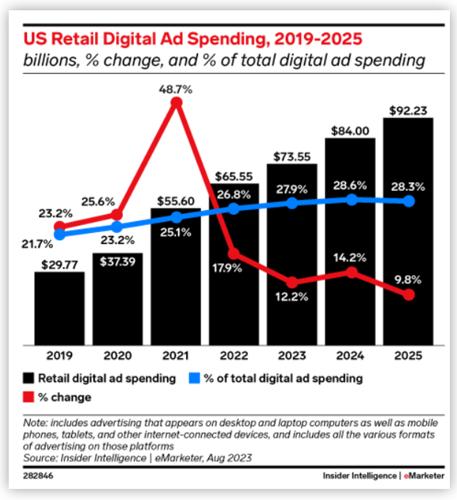
II. Adaptability to new technologies - An ongoing commitment to technological adaptability is required to remain competitive in digital advertising. Businesses should regularly monitor emerging technologies like artificial intelligence, machine learning, augmented reality, and virtual reality. Early adoption of these technologies can give companies a significant competitive advantage, allowing them to provide unique and engaging ad experiences. Incorporating innovative ad formats such as interactive content or shoppable ads in a crowded digital landscape can capture audience attention and differentiate brands. Furthermore, businesses should foster an innovation culture by encouraging experimentation with new technologies to constantly refine and improve their digital advertising strategies.
III. Transparency - Businesses must prioritize adherence to evolving regulations and demonstrate a commitment to transparency as data privacy concerns become more prominent. A trustworthy digital advertising strategy is built on adhering to data protection laws, obtaining explicit user consent, and implementing robust security measures. Transparent communication about data collection and usage practices increases consumer trust and strengthens brand credibility. Businesses should invest in educating their teams on compliance requirements and auditing their data-handling processes regularly to ensure compliance with privacy standards. Creating clear communication channels for consumers to inquire about data practices improves transparency and strengthens the ethical foundations of digital advertising.
IV. Personalization and customer-centric strategies - Businesses should prioritize personalization in their digital advertising strategies in an era when consumers expect personalized experiences. Companies can tailor content and messaging to individual preferences by leveraging data insights, increasing the relevance of ads, and fostering a deeper connection with the audience. Customer-centric strategies, such as targeted promotions, personalized recommendations, and exclusive offers, aid in developing brand loyalty and long-term customer relationships. Businesses should invest in technologies that allow for robust customer data analysis to inform personalized advertising efforts, ensuring that each interaction adds value to the consumer's journey.
V. Continuous optimization and mobility - Businesses must be agile due to the dynamic nature of the digital landscape. Businesses can quickly adapt to changing trends and consumer preferences by continuously monitoring campaign performance metrics and consumer feedback. Ad creatives, targeting parameters, and overall strategy must be optimized on a regular basis to ensure that advertising efforts remain effective and aligned with business goals. Embracing a test-and-learn mindset enables businesses to experiment with different approaches, identify what resonates with their target audience, and fine-tune their strategies as needed. This dedication to skill positions businesses to stay ahead of the rapidly changing digital advertising landscape.
Conclusion
Looking ahead to 2024, the digital advertising landscape in the United States presents both challenges and opportunities for advertisers. Advertisers need to be agile and adapt to evolving consumer behavior while leveraging emerging technologies to create impactful campaigns. Accurate forecasting is crucial, as it depends on user behavior and the products or services the business offers. In addition to running PPC ad campaigns, companies must focus on their core business to provide users with the best products or services. The more satisfied users are, the more traffic increases on the landing page. Running more paid ads and offering discounts and promotions to users can also help boost traffic, which can be added to ad extensions like promotion extensions and sitelink extensions. Hiring a digital marketing company can provide the best results from paid ads. For this, white label PPC services can be availed.
Outsourcing PPC services increases the performance of the paid ad campaigns as the PPC professionals focus on optimizing the performance of the website. You can also avail of offshore PPC services and hire PPC experts to manage ad campaigns effectively and provide the best advertising ROI. By understanding the trends and key factors influencing digital ad spending, businesses can position themselves for success in the dynamic world of digital marketing. We understand that businesses with extensive workloads often find it challenging to establish a strong online presence. That's why we provide PPC services tailored to various industries, including painting PPC, plumbing PPC, construction PPC, appliance repair PPC, and HVAC PPC services.
References:
. Ad Spending Growth To Accelerate In 2024
. US advertising and agency hiring soars amid forecasts calling for 2024 spending growth

